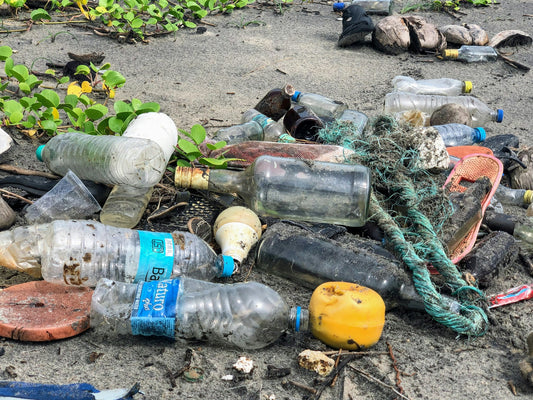Share
Many of us dispose of used dead batteries and even gadgets in our household waste. But, have you ever thought about where they end up and what impacts can they have on our environment?
Electronic waste, or e-waste, is a rapidly growing global waste stream. As technology advances, gadgets' life cycles shorten, increasing the rate at which electronic waste is generated.
The total amount of e-waste produced globally in the past few years has become staggering, and it has devastating impacts on the environment and human lives.
In this article, we will look at some of the impacts of e-waste on the environment and the extent of this problem.
The Global Challenge of E-Waste

The Global E-waste Monitor indicates that e-waste production reached 62 Million tons in 2022, which is 82% higher in comparison to 2010. It is also predicted that by 2030, production will exceed 80 million tons.
Some e-waste exportation techniques are unlawful, such as labeling containers incorrectly or mixing e-waste with other consignments.
Consequently, over 95% of e-waste treatment occurs through illegal means, leading to significant environmental degradation and health risks. Alarmingly, only 17.4% of e-waste is collected correctly and recycled globally, highlighting a huge gap in effective management.
In the EU alone, 75% of e-waste produced within a year remains untraceable, and many of such waste may be exported illegally. And North America is dealing with the same problem.
The statistics show that the amount of e-waste produced is truly staggering, and it underlines the importance of proper management and recycling.
Different Components of E-Waste and Their Effects on the Environment

E-waste contains both hazardous components and precious metals due to the complexity of the products.
Some of the elements used in this process include lead, mercury, cadmium, and flame retardants, which can be dangerous if not disposed of in the right manner.
If e-waste is not handled correctly, these hazardous elements become a threat to the environment and human health, polluting soil and water sources.
Soil Contamination
Soil pollution is one of the most significant impacts that e-waste has on the environment.
When the electronic equipment gets to the landfill sites, it decomposes and emits hazardous substances.
Lead, for example, is present in most electronic devices, such as cathode ray tubes (CRTs) used in older television sets and computer displays.
As these devices begin to degrade, they leach lead into the soil, thereby making it dangerous for use.
This contamination can harm plants, decrease the soil’s ability to provide nutrients to plants, reach the food chain, and directly affect people.
Water Pollution
E-waste also has a very high impact on water bodies and other resources. The toxic substances in e-waste, when discharged into the soil, contaminate the groundwater and surface water resources.
This can cause water pollution, which can be devastating for both humans and animals. The most dangerous is mercury, which is used in batteries, switches, and fluorescent lamps, for example.
Mercury discharges into water bodies go through a process where they are converted into methylmercury, which is highly toxic in water bodies and can easily enter the food chain.
People who consume these contaminated fish are prone to suffer from severe health complications such as neurological and developmental disorders.
A study conducted by the United Nations University confirmed that if e-waste is not disposed of correctly in the developing countries mentioned above, it is usually incinerated or dumped in water reservoirs, which causes water pollution.
The leaching of chemicals such as mercury and cadmium into water sources is a major concern for the environment and human health.
|
Planned Obsolescence is a major contributor to the increase in e-waste. Read our article to learn more. |
Air Pollution
One of the most conventional and dangerous practices that are widely used in many developing countries is the burning of e-waste.
This process emits a combination of toxic gases, such as dioxins, furans, and polycyclic aromatic hydrocarbons (PAHs).
These pollutants are toxic and can have adverse effects on the environment and the health of people as well.
In Agbogbloshie, a suburb of Accra, Ghana, one of the largest e-waste recycling centers in the world, burning wires to recover copper releases toxic fumes into the air.
This has led to high levels of air pollution in the area, especially respiratory problems skin diseases, among many other health complications.
These toxic substances that come out during burning spread several kilometers, hence causing air pollution and respiratory diseases even in areas that are not near the source of burning.
These are pollutants that one inhales, and they cause various diseases, such as cancer, respiratory diseases, and neurological disorders.
Health Risks Associated with Exposure to E-Waste

Respiratory Problems
The incineration of e-waste leads to the emission of toxic gasses, which can be a major cause of respiratory illnesses.
These fumes cause ailments such as asthma and can progress to chronic respiratory illnesses.
Inhalation of pollutants from e-waste can cause diseases such as asthma, chronic bronchitis, and even lung cancer.
Exposure to Harmful Substances
E-waste is comprised of a variety of hazardous substances such as nickel, zinc, lead, chromium, barium, dioxins, and flame retardants.
These substances, if ingested in large quantities, can have very disastrous effects on the human body.
"A child who eats just one chicken egg from Agbogbloshie, a waste site in Ghana, will absorb 220 times the European Food Safety Authority daily limit for intake of chlorinated dioxins." Says a WHO report.
This is the case with lead, which can impact the blood, kidneys, and nervous system. It is especially risky for pregnant women as it is associated with stillbirth, premature birth, and low birth weight of the baby.
Growth and Development of Unborn Children
Various research studies indicate that pregnant women who are exposed to e-waste pollutants are likely to have adverse effects on the unborn child.
These effects include lower neonatal behavioral scores, higher rates of mental health issues, and lower cognitive function.
Cancer Risks
The pollutants found in e-waste have been found to be carcinogenic and can lead to lung cancer among users.
A study of the vicinity of a chinese e-waste facility revealed that up to 1200 in a million people living in the area would develop lung cancer in their lifetime directly caused by E-waste exposure.
How Can We Combat E-Waste?
It is essential to note that combating e-waste is not an individual task but a collective effort of everyone, including manufacturers and the government.
Proper recycling of e-waste is important so that valuable materials can be extracted and hazardous substances disposed of.
Consumers should use accredited e-waste recycling facilities to get rid of their old electronics.
Consumer awareness of the environmental effects of e-waste and the necessity of proper disposal must be promoted.
Awareness campaigns can encourage people to recycle their old devices, repair the devices instead of buying new ones, and purchase items with longer usable lives.
How do you dispose of e-waste? Leave a comment below and engage in the discussion!
We hope you enjoyed this article. If you want to read more like this, make sure to check out our Blog and follow us on Instagram. If you are interested in truly sustainable products, check out our Shop.








